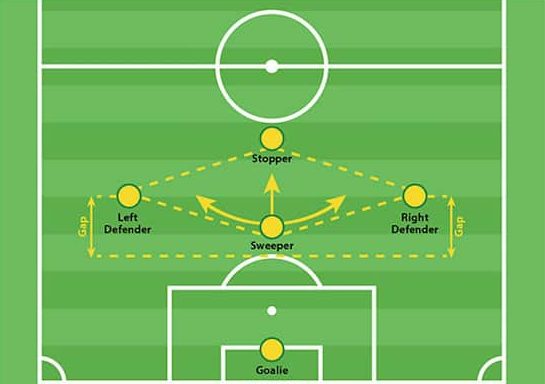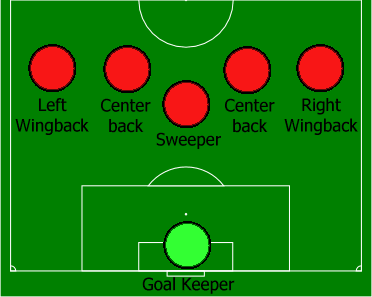The sweeper is one very rare and specialized form of defensive position in soccer, which has had great tactical significance within the game.
Though modern forms have moved away from including a traditional sweeper within their formations, learning the role can help to contextualize how the defense in soccer has evolved.
Let’s explore what exactly it entails to be a sweeper, their roles, and how this position has adapted over time.
What is a Sweeper in Soccer?

The sweeper is a defender who plays behind the main line of defenders to clean up those opposition players getting past the backline. They “sweep” loose balls, cover teammate’s mistakes, and nullify any attack that breaks through.
Playing behind the back four, they often have additional security, finding themselves to be the last line in front of the keeper on many occasions.
Unlike other defenders, who often have specific marking duties, the sweeper is at liberty to read the game and react appropriately to situations unfolding.
Flexibility, therefore, arises in being able to anticipate dangerous situations and intercept passes while clearing the balls that have otherwise presented goals to their opposing team.
CHECK OUT | Best Soccer Speed of Play Drills: Boost Your Skills
Sweeper Responsibilities
The roles undertaken by a sweeper sum up to both defensive and offensive responsibilities:
Defensive Responsibilities
- Providing Cover: A sweeper covers the back for the main defensive line; if attackers manage to break through, then a sweeper intervenes by making crucial tackles or blocks.
- Intercepting Threats: Sweepers read the game well with good positioning to intercept passes and disrupt attacking plays before they become dangerous.
- Organizing the Defense: Very often, sweepers also have to act as the defense coordinator since they have to communicate with fellow players regarding structure and compactness at the back.
- Making Last-Ditch Tackles: High-pressure moments definitely need a very timely and accurate sweeper to stall attackers without giving away any fouls in dangerous areas.
Offensive Contributions
- Transitioning Play: The sweeper is not obligated to mark an opponent, so they can roam forward with the ball, utilizing their vision and passing to initiate counterattacks.
- Playmaking: Some sweepers take on a “libero” role, where players feature in the build-up of the team’s offense from the back through playmaking.
The Origin and Evolution of the Sweeper Role

The position of sweeper is the evolutionary product of the early 20th century due to various forms of tactical systems. It was Austrian coach Karl Rappan who, in the 1930s, introduced this concept along with his “verrou” formation.
This sweeper acted as additional defense, which balanced the weaknesses of players that were not that skilled.
It gained great prominence in Italian soccer during the 1960s with the “Catenaccio” system, a defensive system in which a solid backline was important, with the sweeper playing a pivotal role in neutralizing attacks and orchestrating counterattacks.
Italian clubs found immense success using this system, showcasing the sweeper’s importance.
In the 1970s, this position of the sweeper further evolved with the “Total Football” philosophy of the Dutch. This system required versatility, including from the sweeper, whereby players were supposed to take part both in defense and offense.
As soccer tactics continued to evolve, the rigid reliance on a sweeper gave way to zonal marking and high-press systems. Today, the sweeper role is extremely rare but still exists in specific formations and styles.
CHECK OUT | Top Winter Soccer Training Options to Stay Competitive and Build Your Skills
Key Skills and Attributes of a Successful Sweeper
Being a sweeper requires a unique blend of physical, tactical, and technical skills. The following are the key qualities one would need:
Tactical Intelligence
- Game Awareness: The sweeper needs to be highly endowed with soccer IQ that will help him predict opponents’ moves and place himself well.
- Decision-Making: This is crucial to decide on tackling, intercepting, or retreating.
- Speed and Stamina: The ability to cover large areas of the field and track fast attackers is crucial.
- Strength: Physicality helps sweepers win duels and maintain control in challenging situations.
Technical Skills
- Tackling: Clean and precise tackling is vital to avoid conceding free kicks or penalties.
- Passing: Strong passing ability enables the sweeper to transition play and connect with midfielders or forwards.
CHECK OUT | What Skills Should a Girls U14 Soccer Player Have?
How Does a Sweeper Differ from Other Defensive Roles?
The sweeper is similar to the other defensive positions but different because of the unique role that it has and its place on the pitch.
Sweeper vs. Center Back
While the center back will be tasked with marking a player who is attacking them and staying in position on the top of the defensive line, the sweeper plays behind the defense by supporting them and filling open gaps.
Sweeper vs. Stopper
The stopper is a more aggressive defender who plays higher up, directly challenging attackers and preventing them from reaching the backline, while the sweeper stays behind the defense, acting as a safety net and cleaning up any missed challenges.
Modern Formations and the Decline of the Sweeper Role
The sweeper was a staple in traditional formations like the 4-4-2 or 3-5-2, where their presence reinforced the backline. But as soccer tactics have shifted, the role has become less common.
Modern teams now rely on zonal marking, where defenders cover specific areas, and high pressing, which prioritizes collective pressure over individual roles.
Despite this decline, versions of the sweeper position still pop up in various systems.
For instance, in a 5-3-2, the center-back might adopt some sweeper-like responsibilities, offering additional insurance to the team’s wing-backs as those players press further forward.
Tips for Playing as a Sweeper
For players who wish to excel as a sweeper, here are some practical tips:
- Become the Skipper: Communicate effectively with your teammates, organize the defense, and clearly give instructions.
- Discipline: Patience and attention to timing tackles are fundamental to avoid unnecessary risks.
- Develop Positional Awareness: Continuously scan the field, anticipate opposition moves, and position yourself favorably.
- Improve Reflexes: Quick reactions are required to intercept passes and also to respond to sudden threats.
- Build Fitness: High levels of stamina and agility are essential for maintaining performance throughout the game.
- Improve Technical Skills: Tackling, passing, and ball control to contribute both in defense and offense.
CHECK OUT | Top Skills for a Successful Girls U14 Soccer Goalie: What Coaches Look For
Benefits of Using a Sweeper
Though the sweeper position may be rare in today’s game, it still holds some distinct advantages in specific situations:
Greater defensive solidity, since the presence of the sweeper acts like an added layer of security, reducing the chances of conceding a goal.
- Flexibility in Play: The sweeper can adapt to both situations, whether defensive or offensive, offering versatility to the team.
- Increased Creativity: Due to the sweeper’s freedom, they can often contribute to playmaking, adding surprise to the team’s attack.



